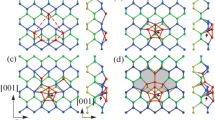Abstract
The initial stages of growth of Ge and Si layers on a singular Si (111) surface result in an unusual morphology of the growth surface if the layers are deposited at a low rate; i.e., triangular islands with a height of as much as three atomic layers are formed. A simulation based on the Monte Carlo method has been used to show that an additional barrier with a height of 0.5–0.6 eV, serving to incorporate atoms into dimerized bonds at the edges of the triangular islands, brings about enhanced growth of the islands in relation to their height and a change in the triangles’ orientation. According to the suggested hypothesis, the increase in the islands’ height and the limitation of their height to three bilayers are due to the effect of the edge dimers, whose orientation changes when the height of a step perpendicular to the \(\langle \bar 1\bar 12\rangle \) direction becomes as large as three bilayers. Scanning tunneling microscopy has been used to detect new special features in the atomic structure of regular three-bilayer steps on a Si (557) surface. The results of an analysis of the images obtained using a scanning tunneling microscope confirm the hypothesis that a row of dimers is formed at the edge of a three-bilayer step.
Similar content being viewed by others
References
V. G. Dubrovskii, G. E. Cirlin, and V. M. Ustinov, Phys. Rev. B 68, 075409 (2003).
G. Jin, Y. S. Tang, J. L. Liu, and K. L. Wang, Appl. Phys. Lett. 74, 2471 (1999).
J. Viernow, J.-L. Lin, D. Y. Petrovykh, et al., Appl. Phys. Lett. 72, 948 (1998).
J. Viernow, D. Y. Petrovykh, F.-K. Men, et al., Appl. Phys. Lett. 74, 2125 (1999).
R. A. Zhachuk, S. A. Teys, A. E. Dolbak, and B. Z. Olshanetsky, Surf. Sci. 565, 37 (2004).
A. Kirakosian, R. Bennewitz, J. N. Crain, et al., Appl. Phys. Lett. 79, 1608 (2001).
K. Brunner, Rep. Prog. Phys. 65, 27 (2002).
Zh. I. Alferov, Fiz. Tekh. Poluprovodn. (St. Petersburg) 32, 3 (1998) [Semiconductors 32, 1 (1998)].
S. A. Kukushkin and A. V. Osipov, Usp. Fiz. Nauk 168, 1083 (1998) [Phys. Usp. 41, 983 (1998)].
V. I. Trofimov and V. A. Osadchenko, Growth and Morphology of Thin Films (Énergoatomizdat, Moscow, 1993) [in Russian].
V. I. Trofimov and V. G. Mokerov, Dokl. Akad. Nauk 375, 465 (2000) [Dokl. Phys. 45, 643 (2000)].
B. Voigtlaender, Surf. Sci. Rep. 43, 127 (2001).
S. A. Teys and B. Z. Olshanetsky, Phys. Low-Dimens.Semicond. Struct., No. 1/2, 37 (2002).
U. Kohler, O. Jusko, G. Pietsch, et al., Surf. Sci. 248, 321 (1991).
A. B. Talochkin and S. A. Tiis, Pis’ma Zh. Éksp. Teor. Fiz. 75, 314 (2002) [JETP Lett. 75, 264 (2002)].
D. J. Chadi, Phys. Rev. Lett. 59, 1691 (1987).
Y. W. Mo, R. Kariotis, B. S. Swartzentruber, et al., J. Vac. Sci. Technol. A 8, 201 (1990).
Zh. Zhang, F. Wu, H. J. Zandvliet, et al., Phys. Rev. Lett. 74, 3644 (1995).
H. Okada, Y. Fujimoto, K. Endo, et al., Phys. Rev. B 63, 195324 (2001).
J. Cai and J.-S. Wang, Phys. Rev. B 64, 035402 (2001).
Y. Fujikawa, K. Akiyama, T. Nagao, et al., Phys. Rev. Lett. 88, 176101 (2002).
K. Takayanagi, Y. Tahishiro, S. Takahashi, and M. Takahashi, Surf. Sci. 164, 367 (1985).
M. Hupalo, C. Z. Wang, B. J. Min, et al., Phys. Rev. B 67, 115333 (2003).
I.-S. Hwang, Mon-Su Ho, and T. T. Tsong, Phys. Rev. Lett. 83, 120 (1999).
B. Z. Olshanetsky and A. A. Shklyaev, Surf. Sci. 82, 445 (1979).
I. G. Neizvestny, N. L. Shwartz, Z. Sh. Yanovitskaya, and A. V. Zverev, Comput. Phys. Commun. 147, 272 (2002).
H. Nakahara, M. Ichikawa, and S. Stoyanov, Surf. Sci. 329, 115 (1995).
L. V. Sokolov, M. A. Lamin, V. A. Markov, et al., Poverkhnost, No. 6, 53 (1991).
V. Cherepanov and B. Voigtlander, Appl. Phys. Lett. 81, 4745 (2002).
Author information
Authors and Affiliations
Additional information
__________
Translated from Fizika i Tekhnika Poluprovodnikov, Vol. 39, No. 8, 2005, pp. 1002–1011.
Original Russian Text Copyright © 2005 by Zverev, Neizvestny, Reizvikh, Romanyuk, Teys, Shwartz, Yanovitskaya.
Rights and permissions
About this article
Cite this article
Zverev, A.V., Neizvestny, I.G., Reizvikh, I.A. et al. Causes of the stability of three-bilayer islands and steps on a Si (111) surface. Semiconductors 39, 967–977 (2005). https://doi.org/10.1134/1.2010695
Received:
Accepted:
Issue Date:
DOI: https://doi.org/10.1134/1.2010695




